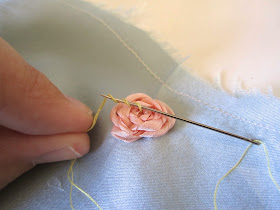Let's discuss bra straps!
I have chosen to use some very delicate silk ribbon for my straps. I'm going for a very dainty, light weight, almost gossamer effect with this bra and I don't want too heavy of a strap. However, I can get away with that because, let's face it, I'm tiny up top and I don't need any support. If you're larger up top and using a heavier weight fabric than charmeuse or crepe de chine, I recommend using either purchased straps or at least silk satin ribbon. It's heavier and sturdier.
If you'd prefer to make some adjustable straps of your own, check out this great tutorial over at Ohhh Lulu.
For a more hand-stitched route, you can use this old-fashioned technique for adding bra straps to a finished bra without sewing the strap between layers.
I chose to sew my straps between the layers this time just to mix things up.
You'll need to test the fit of your bra at this point and (with some help if you can get it) pin a length of ribbon to the front and back of the bra to help you measure how long your strap should be.
As a starting point, my straps were about 20" long with seam allowances figured in.
Before starting on straps, place the two bra layers right sides together, then pin and sew the bottom seam only. This makes it easier to wrangle your layers when doing the next two steps.
--Tip for working with slippery fabrics: Years ago, I remember asking my Mama about how to work with slippery silk and she responded with "When in doubt, sweetie, just pin the hell out of it!" Mama was right - it works like a charm.
Now the easiest way to sew a bra strap (ribbon) between layers is below. Simply roll that sucker up and paper clip it, leaving a few inches out to work with. This will keep your ribbon from straying all over the place as your work with it, and more importantly, it keeps your ribbon from going rogue and getting caught in a seam somewhere!
 |
| A paper clip can keep your ribbon from going rogue. |
The best place for your bra strap placement at the front is just to the outside of your upper dart, though during a fitting with your muslin, you should test and see if this works for you too.
 |
| My two layers of fabric, open at the top and ready for the ribbon. |
 |
| Add the ribbon just to the outside of the upper dart (the side closest to the under-arm). |
The back end of the straps is going to be stitched to the outside of my bra once everything else is finished.
Now for the bra back closure. I'm using my usual French bra back closure (I won't use any other closure method any more!) but you can use any other method you're comfortable with.
For a button and ribbon loop closure, check out this tutorial.
You want to make sure that any bra closure method you use is facing to the inside of the bra as you sew the layers completely together. That way, when you turn your bra right side out, the closure is on the outside.
If you go this route, test your closure on your muslin version. You'll want the hook opening to be facing up, but which side do you want the hook on? Left or Right? This depends on what feels most comfortable for you and perhaps which of your hands is dominant.
Once you have your closure pinned securely in place, (this is another good time for a fitting!) you can pin the rest of the outer and lining together, matching seams and darts.
Stitch the layers together, taking time to back-stitch at the bra strap edges and closure for extra strength. Be sure to leave at least a 2" gap open towards the back so that you can turn the bra right side out!
First trim down the corners of the back of the bra, then carefully turn your bra right side out, press the edges, and slip-stitch the gap closed.
To secure your bra straps to the back of the bra, you can either use the old fashioned method mentioned above or do as I did.
I simply folded the raw edge under 1/2" and then hand-stitched the ribbon about 1" away from the back of the bra edge.
Annnnd, we're done!
I pressed the black edge of the bra up just a tiny bit fron the blue side and it the way it sits looks like there is a little bit of contrast piping.
 |
| I'm in love with my French knots... I want to put them on absolutely everything now! |
Did we just sew a completely reversible bra? Why yes, yes we did ;)
Tada!
Any questions, my dears?
P.S. For those of you just tuning in, you can find all of our Sewing #610 posts, as well as where to find the pattern by clicking here.
































